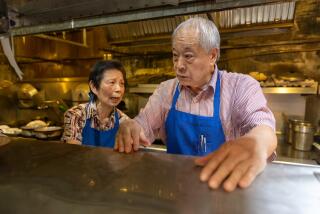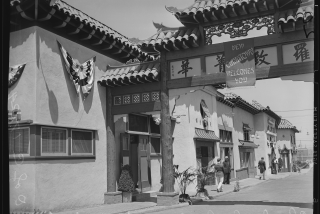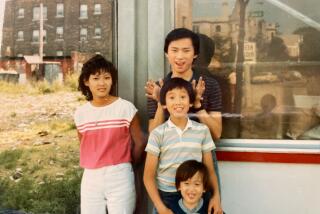How the West was built: Project seeks stories of Chinese workers
Reporting from Stanford — In May 1969, Connie Young Yu’s mother and father traveled to Utah from the Bay Area for ceremonies marking the 100th anniversary of the transcontinental railway. Like thousands of Chinese Americans, their migrant-laborer forefathers had worked on the massive project that culminated in California rail baron Leland Stanford driving the celebrated golden spike at Promontory Point.
But her parents’ pride quickly turned to dismay as they listened to Transportation Secretary John Volpe’s remarks, which ignored the Chinese migrant contribution.
“He gave this oration saying, ‘Who but Americans could have blasted tunnels through the Sierras? Who but Americans could have built 10 miles of track in one day?’” recalled Yu, 73, a historian and author who lives in the Bay Area city of Los Altos. “He had no clue of the history.”
In the decades since, Yu and other grass-roots history buffs have sought — with limited success — to flesh out the stories of these long-anonymous Chinese migrants and win wider recognition for their role in the building of the American West. But now their efforts are getting a boost from a somewhat unlikely quarter: Stanford University, founded by none other than Leland Stanford.
Scholars at the school have launched the Chinese Railroad Workers in North America Project, endeavoring to collect the most complete record of these migrants’ journey to the American frontier and their subsequent experiences. The effort has grown since 2012 to involve more than 100 researchers and volunteers in the United States, Canada and Asia, in fields as varied as anthropology and architecture. Together, they aim to generate articles, books and a digital archive, along with curricula and public events.
“This university wouldn’t exist without these workers. Leland Stanford was rich, but he became fabulously rich because of the railroad,” said Hilton Obenzinger, associate director of the project. “He could create a university because of the Chinese workers who built the railroad.”
Remarkably little is known of the 12,000 Chinese migrants who came to build the railways in the 1860s. Many are listed in surviving records simply with monikers like “China Sam” or “China Jim.” Researchers have yet to find any primary document, such as a letter home or a diary.
“We have one line of calligraphy in a payroll record from the Central Pacific Railroad” by a worker, said Shelley Fisher Fishkin, director of Stanford’s American Studies program. “It’s excellent calligraphy, by an educated person probably with an accounting background.”
Researchers believe that many of the laborers were merchants, traders and blacksmiths seeking opportunity in the United States after the Opium Wars, Taiping Rebellion, natural disasters and famines. Most of the migrants, many of them educated men, came from the southern province of Guangdong.
“They were not just strong backs,” said Gordon Chang, director of Stanford’s Center for East Asian Studies. “They were ambitious people making their way. There was a variety of identities; they came from different strata or classes. They had different skills, including cooking, accounting, carpentry and masonry.”
In early June, about 250 people came to the Stanford campus for a conference on topics such as railway labor strikes and archaeological findings that shed light on the daily routines of the workers. Descendants of about 50 railway workers came from as far away as Hawaii and shared oral histories, a key source of information for the project.
San Francisco filmmaker Barre Fong, has conducted video interviews with dozens of Chinese Americans, including prominent authors Maxine Hong Kingston and Lisa See, about their railway-worker ancestors. He is aiming to create an hour-long documentary on the subject in affiliation with the Stanford effort.
“Up to now, we kind of have this image of nameless, faceless men with big straw hats,” said Fong, 48. “We got some pretty interesting details about who they were, who they left behind and why they left China, and the legacy they left behind in the United States.”
Chin Lin Sou, a fluent English speaker, went on to become a prominent Denver businessman. Hung Lai Woh came over as a teenager and built sheds to protect the rail tracks from heavy snowfall. He later ran a cigar business in San Francisco.
See’s great-great grandfather — whom she described as an illiterate “snake oil salesman” — was hired to serve as an herbalist for the laborers.
Another descendant, Sandy Lee, told researchers that her great-grandfather’s work team was accosted by an Indian tribe and that the chief, who had recently lost his son, “adopted” the young Chinese man for two years. After he was freed, he went back to China, married, then joined his brother in Maryland and took up farming.
Many Chinese who built the railroads were not eager to recount their experiences. Filmmaker Fong himself had a great-grandparent who served as a cook on the railroad, but rarely discussed it.
“It was not a proud time in his life, so it was only mentioned in passing, never in detail,” Fong said. “I’ve asked all my relatives, and they say he never talked about it.”
But in recent years, Chang said, many Chinese Americans have come to regard this period with honor.
“These workers were the ancestors of many Chinese Americans today. Others see them as their forebears even if they’re not related to them,” Chang said. “There’s a romanticism and a heroism around them now.”
The Stanford effort coincides with a burgeoning interest among some Chinese mainlanders in exploring 19th century Chinese migration. Li Ju, a Beijing-based amateur photographer, has spent months in the United States, tracing the route followed by the railway workers and taking pictures of sites documented by the Central Pacific Railroad’s official photographer.
Last year, Li helped reporters from a Chinese newspaper visit some of the sites; a book of his photographs will be published this summer in China.
“I’m an educated person, I went to college, but until I visited the U.S. In 2010, I myself had never heard about this history,” said Li, 56.
Historians in Guangdong, meanwhile, are in the midst of eight-year project to trace migration from the province.
Selia Tan, an architectural historian at Wuyi University in Guangdong, who is part of the Stanford project, said many documents in China were destroyed during the upheaval of Mao’s 1966-76 Cultural Revolution. And whatever personal letters that survived the purges might not serve as reliable historical records, she said, because migrants often “tried to keep the harsh realities from their family and reported only the good news in their letters home.”
Still, Chang says modern technology is helping researchers piece together information in ways that would have been impossible a few years ago.
“Digitization of newspaper archives and other records, email and other tools make it possible to collaborate across borders in way that previous generations of scholars couldn’t,” Chang said.
While working on the American railroads, Chinese laborers faced systematic discrimination. They received less pay than Irishmen and had to provide their own food and accommodations. Later, the Chinese Exclusion Act of 1882 barred the immigration of Chinese laborers; other legislation restricted schooling and property ownership.
Some percentage of the migrants — it’s not clear how many — eventually returned to China; one from the Seattle area, Chin Gee Hee, was a driving force behind the Sunning Railroad in the Pearl River Delta, the first railroad in that region.
The Stanford researchers have traveled to the ancestral villages of some workers but have yet to make contact with any direct descendants. Fong says many Chinese today — even those who have migrated to the United States in recent decades — don’t see any connection between themselves and the railroad workers.
“They say, ‘Oh, I’m not interested in the past, I’m interested in the future.’ My feeling is yes, you can take an airplane over from China now, and with enough money you can buy a home anywhere you want, you can send your child to Stanford or UCLA you can start a business anywhere. But that was not the case even in my lifetime,” said Fong, 48.
“For people who think it was always like this in America, it’s misguided. The way was paved by several generations that really suffered and worked very hard under systematic oppression. … I hope projects like this help the newly arrived see this.”
Special correspondent Violet Law in Hong Kong and Nicole Liu of The Times’ Beijing bureau contributed to this report.
More to Read
Sign up for Essential California
The most important California stories and recommendations in your inbox every morning.
You may occasionally receive promotional content from the Los Angeles Times.










